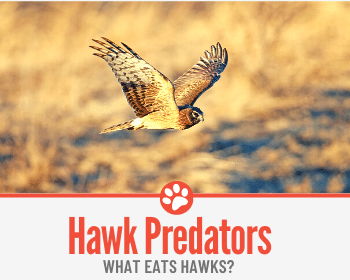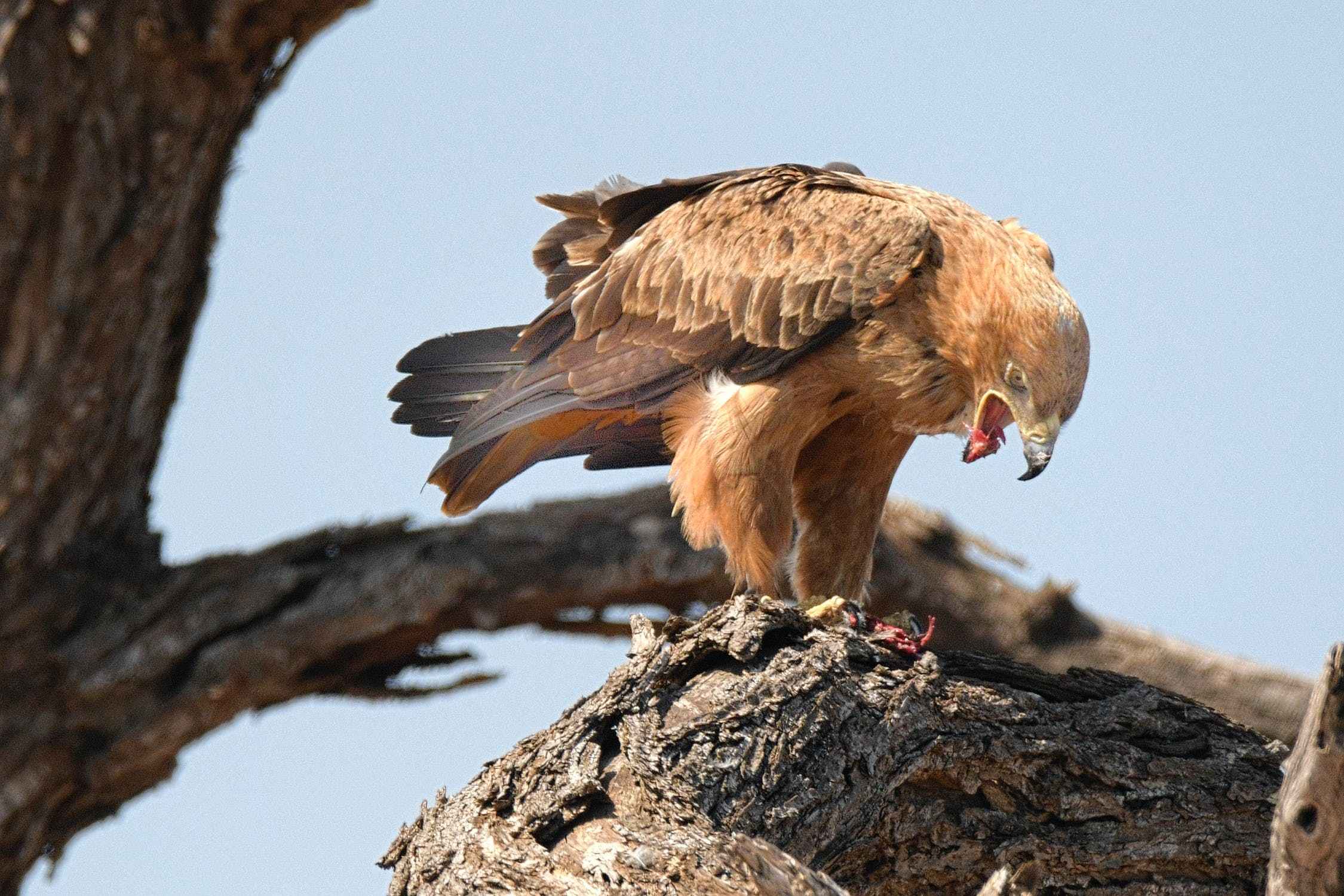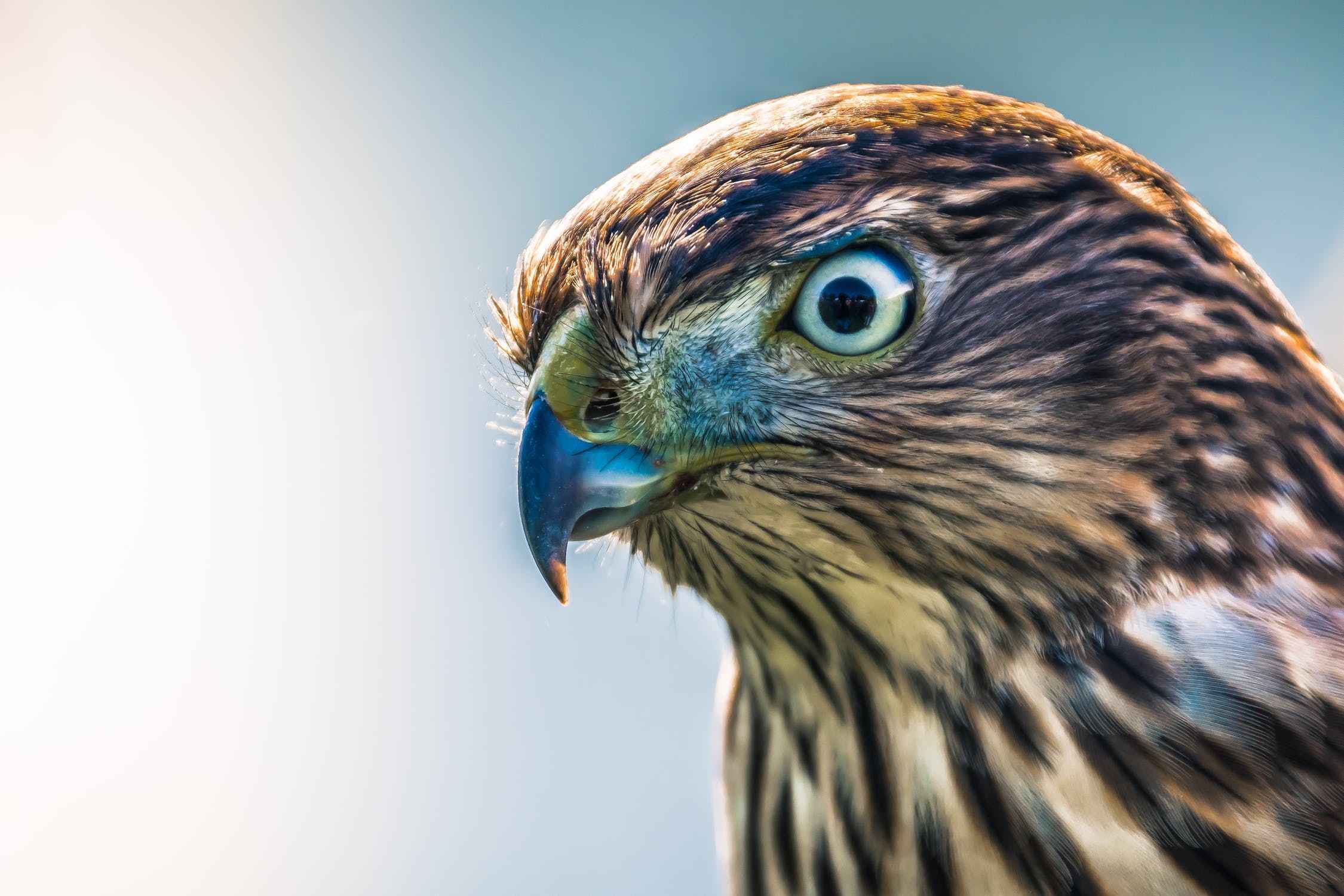 From the skyscrapers of New York city, to the rainforests of the Amazon, hawks can be seen swooping down on their prey.
From the skyscrapers of New York city, to the rainforests of the Amazon, hawks can be seen swooping down on their prey.
Known to be excellent hunters with keen eyesight and deadly talons that grip with four times the strength of humans, who or what could possibly hurt these beautiful creatures?
Hawks are predators, not prey, right? Surprisingly, I found out that’s not always the case.
What Animals Eat Hawks?
Hawks get eaten by Owls, larger hawks, eagles, crows, ravens, racoons, porcupines, and snakes have all been known to make a meal out of hawks. However, it is almost always the young hawks or eggs these predators are after.
Adult hawks actually have very few natural enemies. With their deadly beaks and talons, hawks fly far beyond the reach of larger predators—literally and metaphorically. They are considered a top-level predator, meaning they don’t have many other animals actively hunting them. Remember those food-chain charts in biology class?
The ones pointing to which animals eat which?
Hawks are at the top of these food chains, eating a wide variety of food from any kind of rodent, to fish, to deadly rattlesnakes. Most of the time they are the ones doing the hunting and not the other way around.
Although hawks are most often predators, not prey, it certainly does occur that other animals large and strong enough can eat a hawk. The animal kingdom is not always so neatly divided into predator and prey, and if there’s an opportunity to snack on a hawk, a large, hungry predator will.
Do Coyotes and Foxes Eat Hawks?
Both members of the Canidae family, foxes and coyotes are talented predators. But can they rise to the status of predator for this skillful raptor? The answer is possibly, but rarely.
Coyotes are one of those less picky animals who will eat whatever they can they can get their paws on. They will eat anything from grass and fruit to carrion (animal carcass), so they will certainly eat a hawk if they have the opportunity. Still, their favourite animals are typically small mammals such as rabbits, so adult hawks are probably not at the top of their menu.
Red foxes, the most common fox, also seems to prefer small mammals as their dominant food source. Birds typically are not their favourite, and foxes tend to only feed birds to their young kids.
The exception is found in some forested regions where birds can make up a large portion of a fox’s diet. Even so, foxes are not usually going to go after birds of prey with their fierce beak and talons to contend with. Instead, they choose easier prey like song birds, doves and pigeons, domestic birds, etc. For a fox to be able to eat a grown hawk, it would probably have to be one already injured.
When Your Lunch Thinks You’re Lunch
One animal that might eat a hawk is a snake. Actually hawks are usually natural predators of snakes and include them in their diet. But sometimes, a tasty reptilian lunch can turn into a nasty fight. There have been several reports of hawks trying to catch a snake and almost becoming lunch itself.
One video captured a Red-Tailed Hawk tangled up with a non-venomous bull snake—two, equally matched predators fighting to survive.
Fortunately for both of them, the videographer’s friend ended up setting the hawk free and both predators seemed to come away relatively unharmed.
I should note here that it’s not recommended to try to help an injured hawk. Hawks have incredibly strong beaks and talons and can do a lot of damage if you’re not trained. It’s best to leave that to the professionals like a wildlife rehabilitator.
What Eats Young Hawks?
Young hawks, called eyases (pronounced like the flower iris without the r), do have natural enemies and are much more likely to be eaten by other predators than their adult counterparts. The most danger comes when they leave the nest away from the protective watch of their parents.
The parents of hawks are almost always monogamous (having just one mate). They spend about eleven weeks total from incubating the eggs to their young leaving the nest.
Despite their parents’ diligent care, young hawks are the most vulnerable during their first year than at any other point in their life. In fact, the Red-Tailed Hawk—the most common hawk in North America—has a survival rate of about fifty percent after hatching.

Hawk Eating Bird
Besides large mammals, other raptors (a classification for birds with sharp beaks and talons and keen eyesight) pose a threat to hawks and sometimes even eat them. Owls and hawks are for example, deadly enemies since they are often competing for the same prey and nesting sites.
Sometimes the young birds end up being food. The Great-Horned Owl, which has the most diverse diet of North American raptors, considers other young raptors an important food source.
But it’s not just the owl that hunts the hawk. Both hawks and owls have been known to destroy the others’ nests as well as their young.
Eagles and hawks are also natural enemies. Eagles will kill hawks, and like owls, they will compete with each other for nesting sites.
Another way hawks compete with other raptors is to steal their food. Red-Tailed Hawks are known as pirating birds or kleptoparasites since they sometimes steal freshly-caught prey from other raptors. Eagles, such as Bald and Golden Eagles, are also famous for doing this as are other kinds of falcons and hawks.
It’s not just other types of raptors that feed on hawks though. Hawks themselves can feed on other hawks of smaller species.
One such example is Cooper’s Hawks which often hunt and eat Sharp-Shinned Hawks.
Occasionally, though, even deadly enemies can have a change of heart. One famous example of this was Spunky, a young Red-Tailed Hawk that ended up the nest of a pair of Bald Eagles and was cared for like one of their own.
Scientists suspect that the hawk was going to be dinner for the Bald Eagle family, but its cries for food triggered their parenting instinct. The hawklet was instead successfully raised by his adoptive eagle parents and most likely began to consider himself a Bald Eagle.
What Eats Hawks in the Desert and Rainforest?
Since hawks can be found in a variety of environments from rainforests to deserts, what eats a hawk in these various environments depends on which predators are there. Coyotes, for example, are a common desert animal and possible predator of young hawks.
Bald Eagles, though, are more often found near water and so wouldn’t eat a hawk in the desert.
Rainforests, an environment in stark contrast to dry, empty deserts, also house raptors. The birds of prey that dwell in the rainforest include hawks, owls, and eagles. And where there are other raptors, there are sure to be threats to hawks. Almost all rainforests are home to a large eagle that can attack other birds of prey.
These include the Harpy Eagle in South and Central America, the Crowned Eagle of Africa, and the Black Eagle of Asia. The Black Eagle, found all across Asia from India to Indonesia, often raids other birds’ nests and will eat the entire family.
Do People Eat Hawks?
Although many predators have been known to make a meal out of hawk, actually, their greatest enemy is often humans. No, this is not because we like hawk meat, although a few tribes of North America did use to eat hawks occasionally as well as hunt them for their feathers.
But today, hawks are not threatened by humans for their meat. Instead, we are often their enemies by directly or indirectly causing damage to them and their environment.
Disappearing and Changing Environment
Losing land to humans has been one of the greatest threats to hawks as well as raptors in general. Agriculture and logging have been cited as two key factors in the decline of raptors worldwide. The landscape of most countries have changed dramatically in the last several hundred years, and these birds of prey have struggled to keep up.
It’s not just the lack of habitat that hurts hawks; it’s also the changing landscape. When humans introduce new species of plants and animals, this can affect the ecosystem. This specifically affects hawks and other raptors by decreasing the number of plant-eating mammals that they depend on for food.
One study showed how the changing landscape of the United States is benefiting ravens and hurting hawks.
Ravens tend to be more adaptive, don’t mind living close together. These members of the crow family also frequently raid the nests of other birds for their eggs. All of these reasons have led a flourishing raven population compared to their raptor cousins.
Some hawks, though, are more resilient than others. The most common North American hawk, the Red-Tailed Hawks, have not been as threatened since they have more tolerance of humans compared to other species. They also are quite adaptive and can be found in environments ranging from forests to deserts.

Climate Change
We can’t talk about changing environments without talking about climate change. Although it’s not entirely clear all the effects of climate change on raptors, this is certainly another looming threat to the species.
One possible effect we know of is the migration pattern of birds. The Red-Tailed Hawk, among other birds, seems to have given up migrating south due to rising temperatures. More birds skipping the trip south could eventually mean less prey to go around.
Poisoning—Accidental or Otherwise
Besides the indirect threat of climate change and loss of habitats, we also harm these creatures more directly through poisoning. Sometimes this is an accident, such as when a hawk consumes a bird that has swallowed a lead fishing sinker or an animal carcass containing a bullet. Another accidental poisoning may occur in cities from the use of pesticides intended to kill rats.
Other times, this poisoning is intentional. People have been known to intentionally poison hawks, worried that they are after their domesticated chickens or pets. Hawks, in fact, rarely hunt chickens or pets, and are more often a help to farmers by riding the land of nuisances like poisonous snakes.
Actually, most hawks are incapable of flying off with our pets. Hawks, the largest weighing at most four pounds, can only carry off prey that is less than their own weight. This rules out the family house cat which weighs an average of ten pounds.
A false belief about hawks killing chickens almost led to the extinction of one species of hawk in the Carribean. In the Dominican Republic and Haiti, Ridgway’s Hawks were in danger of becoming extinct. Farmers wrongly believed these birds were a threat to their chickens and would shoot them on sight.
They would even go so far as to destroy their nests and the trees they lived in. Fortunately, educational efforts along with relocating the birds has helped prevent their continued decline.
Electrocution
Many raptors suffer from electrocution. This cause of death has been partially responsible for the endangerment of some raptor species. Raptors like to use utility poles as perches from which they hunt their prey. Unfortunately, this can sometimes be a fatal choice.
Electrocution often happens when a bird touches two wires at the same time or a wire and a non-insulated pole. Bird deaths by electrocution can number up to to eleven million each year. Unfortunately, despite decades of work and research to deal with this problem, these numbers haven’t changed much since the 1970’s.
Collisions
You know how it is when you get so focused on a task, you tune out everything else? Hawks get it. They do the same thing when focused on diving down and snatching up their prey. Unfortunately, they sometimes also tune out approaching vehicles.
Actually collisions, whether from cars or buildings, is a problem for the bird population as a whole. An estimated one billion birds perish each year from crashing into buildings. This is second only to pet and feral cats as the largest human-caused threat to small birds.
A Notable Exception
Actually, the most common hawk in North America is one of least threatened. Although the continent can boast of seventeen species, Red-Tailed Hawks are North America’s most common hawk.
These adaptable birds have made a wide range of environments their home and have actually extended their range of habitats in recent years. Still, they do face some of the same dangers as their raptor cousins.
In Conclusion
Hawks, as some of the top predators in the food chain, usually have very few enemies to worry about. The same thing often cannot be said for their young. Many animals enjoy a tasty hawk egg or a young hawklet. These include other raptors such as owls and eagles—some of the more famous enemies of hawks. And of course, many large meat-eaters will eat a hawk if they get the chance.
Nevertheless (and fortunately for them) adult hawks are rarely featured as the preferred food choice by other predators. Humans, while not exactly predators of hawks, are often responsible for their deaths.
This happens mostly through destroying their environment and causing accidental injury like collisions or electrocution. Even so, it’s safe to say these magnificent raptors will be a dominant predator throughout the world for a very long time.
